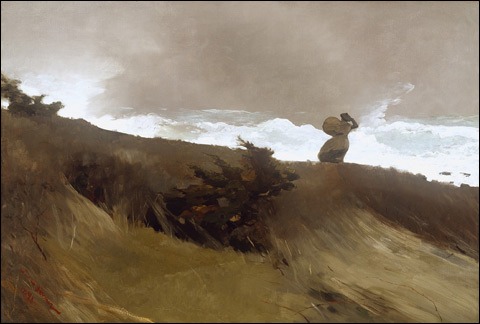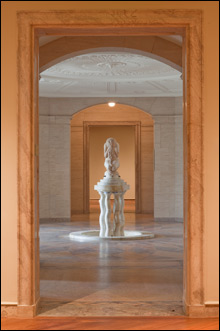
THE WEST WIND: Winslow Homer’s 1891 oil is one of a trio of paintings by that artist that help make the Addison’s American collection second only to the MFA’s. |
Closed for two years of renovation and expansion, the Addison Gallery of American Art at Phillips Academy reopened this past Tuesday with "Inside, Outside, Upstairs, Downstairs: The Addison Anew," nearly 400 greatest hits from its great collection. The 1931 Charles Platt–designed Greek Revival museum has been spruced up with new lighting, security, and climate-control systems, but there are no new galleries. It feels like visiting the home of a neat freak after spring cleaning. Everything looks wonderful, but for visitors coming to check out the galleries, changes will be hardly noticeable.
| “Inside, Outside, Upstairs, Downstairs” | Addison Gallery | 180 Main St, Andover | Through November 5 |
What's new is the Sidney R. Knafel Wing, designed by Centerbrook Architects of Connecticut to sit demurely back and to the left of the original building while linking it with the 1963 Elson Arts Center, a generic International Style studio building. The building fits so smoothly into its red-brick surroundings, you'd think it's been there all the time.
The façade of the three-story, 13,000-square-foot addition is glass behind a curtain of stainless-steel mesh. The mesh almost disappears when you look out; from the outside, however, it's a seemingly solid wall of gleaming silver, depending on the angle of the sun. This isn't just architectural razzmatazz — the fine metal contributes to energy savings by shading the window like tiny blinds.
Inside is a large, airy new Museum Learning Center, visible down a short hall from the Addison's first-floor galleries. "It's not an isolated classroom — we don't see education as something separate from what we do curatorially," says associate director and curator Susan Faxon. "The design was particularly to emphasize that, and that's why it's at the center of our new building."
The room offers handsome blond figured-maple cabinets and shelves for presenting art. An elevator allows easy transport of art from the new storage rooms (the collection is now all on site — previously it was housed in Boston), exhibition-prep facilities, and a loading dock downstairs. New offices are upstairs.
The Learning Center's large windows gaze out on the school's sweeping lawn and, sitting in the sedum of a green roof atop the new wing's first floor, a new addition to the permanent collection, Black Niijima Floats by Dale Chihuly. The 10 variously sized marbled black balls are the project's only misstep. Chihuly can be great fun when he's Technicolor, curvy, and over the top. But when he strips things down, as he does here, you see only how shallow he can be.

VENUS ANADYOMENE: The spruced-up Addison turns Paul Manship’s 1927 marble once again into a showstopper. |
The visitors' desk and bookstore have been moved out of the old museum's entrance rotunda to nooks on the right. It's a small switch for a big effect, focusing attention on late Gloucester sculptor Paul Manship's 1927 naked, marble, Art Deco
Venus Anadyomene fountain (now working again) and turning it once again into a showstopper.
The Addison's collection ranges from endearing, folksy portraits from the 1750s to Diane Arbus's iconic and still rivetingly surreal 1962 photo of a boy bugging out his eyes as he squeezes a toy grenade in his hand. There are dramatic small landscapes by mid-19th-century Hudson River painters Frederic Church and Albert Bierstadt, one of Martin Johnson Heade's hothouse canvases of apple blossoms and hummingbirds from 1871, and a trio of extraordinary late-19th-century Winslow Homer paintings of people confronting the force of the sea. City life appears in John Sloan's famous 1912 painting of women drying their hair on a New York rooftop, Andover alum Walker Evans's 1920s photographic studies of the geometry of New York architecture, and Edward Hopper's 1928 painting of boxcars waiting on a Gloucester track.